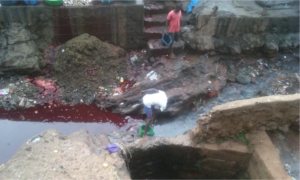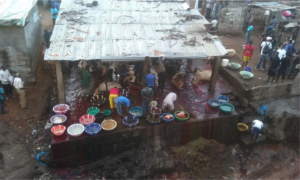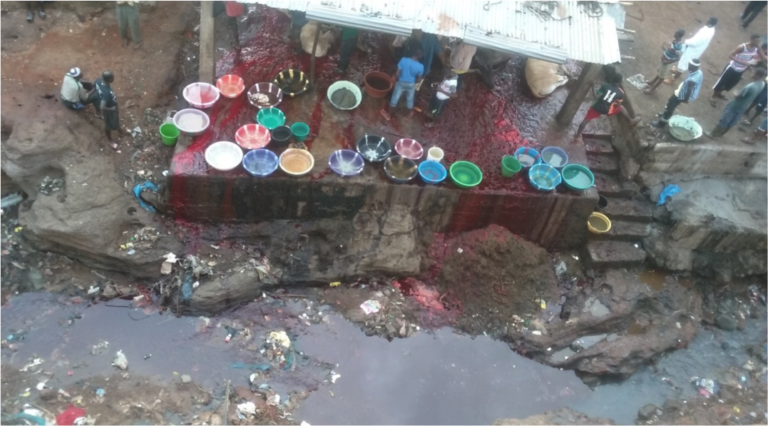By Hasbin Shaw in Freetown, Sierra Leone
Resident of Freetown have raised concern over the highly unhealthy and unsanitary conditions in which cows, goats and sheep are being slaughtered and processed at the “Kissy Abattoir” before they are sold to the public for consumption. Dozens of cows, goats and sheep are being processed each day at the Kissy slaughterhouse, the second largest in the country.
During a visit to the Kissy slaughterhouse on Saturday May 19, 2017, our Correspondent saw piles of cattle excreta lying on the blood-smeared floor, causing putrid smell. The workers of the slaughterhouse do not have any protective gears. They use highly contaminated water, which they fetch in gutters along the abattoir to wash the meats.

A resident of Kissy, Lamin Daramy said, “Abattoir workers always use water from drainage to wash the cow meats after slaughtering. They also fetch water from an abandoned well by a septic tank.”
“This is not good for people’s health,” he added, “people buy these meats every day and I am very sure that people don’t know how these meats are being processed before they are sold to the public.”
According to Daramy, the sanity inspectors from the Ministry of Health are always in the slaughterhouse when these activities are carried out and they do nothing to address the situation. “It is their job to ensure that the meat that is sold to the general public is well taken care of,” he said. “We have had a lot of confrontation with the slaughterhouse workers and the sanity inspectors over the years when we raised these issues with them,” he said.

Another resident, Adama Kamara, said that slaughterhouse workers dump the cattle excreta in the drainage after slaughtering the cow. The gutter becomes a breeding place for mosquitoes and other insects that pose health hazard.
“We suffer the most during the dry season because there is no rain to wash away the waste of the animals,” she said.
The Environmental Health Officer at the Ministry of Health and Sanitation in charge of Zone 1, Sellu Daboh, said that normally the ministry does not allow the slaughterhouse workers to fetch water from the drainage or stream because it is not good. “I will never allow such to happen here,” he said.
“The water they [abattoir worker]fetch from the well is good because it is the same water the community people are using, so I wonder why they are saying it is an abandoned well,” Daboh said
According to the Daboh, the place is perceived to be a slaughterhouse, but it is a slaughter place because a slaughterhouse or an abattoir is where you will expect to have almost 100 percent of logistics.
The vice chairman of Butchers Union Kissy, Mohamed Bah blamed the previous government of neglecting abattoirs. “We used to have a slaughter house in Kissy where we have a water tank and other facilities, but City Council demolished it and promised to build a better one but they didn’t,” he said
Bah accused residents of Kissy of contributing to the poor sanitary condition around the abattoir because they are using the vicinity as a dumpsite.
The existing practice of slaughtering and processing the animals in the city can severely infects meat with germs and other hazardous elements,” said a veterinary officer, Mathew Kargbo. “There is a high risk of getting infected with various diseases, including the zoonotic ones in the conventional slaughterhouses,” he added.
Zoonotic diseases are transmitted from animal to human. Transmission occurs when an animal infected bacteria, viruses, parasites and fungi come into contact with humans. Over 200 diseases like Tuberculosis, Anthrax, Brucellosis and Rabies are currently classified as zoonoses.
The risks can be reduced by setting up modern slaughterhouses, which are supposed to be equipped with facilities like lairage, ante mortem examination, stunning section, flaying, dressing and washing of the carcass, postmortem inspection section, meat processing plant, animal quarantine centres, by-product processing sheds and effluent treatment plant.

